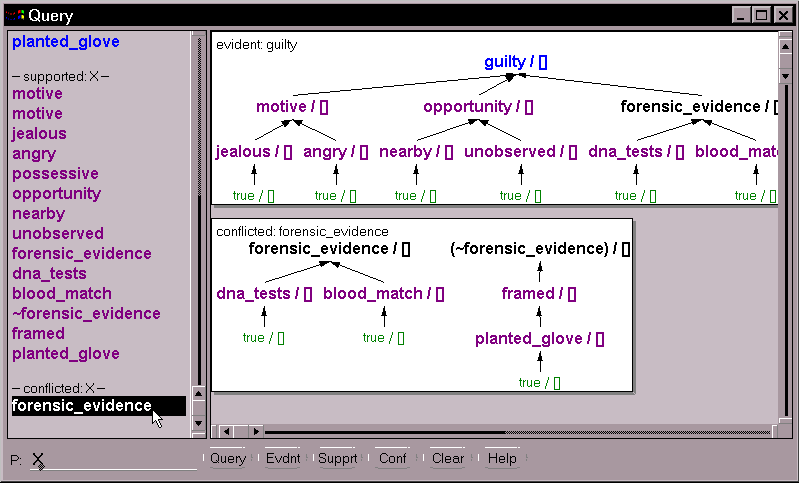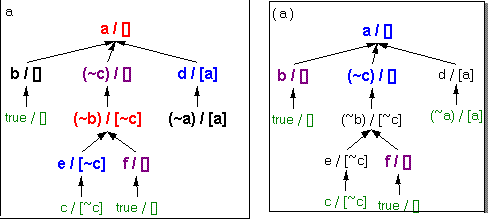VL is a software tool designed to explore the logical
concepts presented in the preceding discussion. It provides various
means for the visual display and manipulation of associated clause
trees. The user interacts with the tool primarily in one of two
'modes.' 'Query' mode allows the user to find evident, supported,
and conflicted terms from the clause database (program). It also
provides 'explanations' in the form of clause trees. 'Explore'
mode on the other hand allows the user to essentially trace the
execution of logic programs by expanding and retracting arbitrary
branches of the clause trees.
Visual Logic was implemented using SWI-Prolog and the graphical package XPCE. Both SWI-Prolog and XPCE were developed at the University of Amsterdam and have been
ported to various Unix/X-Windows environments as well as Microsoft
Windows (Win32s, 95 and NT). VL itself has been written with
portability in mind and should run without modification on any
platform for which SWI-Prolog and XPCE are available.
The tool is composed of several components:
- Main module: integrates
the various modules and provides the main user interface.
- Computation module:
computes derivations for Query mode.
- Explore module: lets
the user explore the logic program's space in a non-linear fashion.
- Query module: lets
the user query the system with specific goals such as "show
all supported propositions" and provides an 'explanation'
in the form of annotated clause trees.
- Results module: accumulates
and shows all known results.
- Built-in editor and program lister:
lets the user edit the input source file (i.e., the program clauses)
and view the current clause database. The source file is a plain
text file consisting of program clauses, the exact syntax of which
will be described in chapter 5.
Below is a screen shot of the tool.
Due to limited screen space, not all windows are fully visible.

Each of the graphical windows corresponds roughly
to a module. The main window (at top) is the command center for
the tool. Here, the user can load the source file, quickly switch
between the various windows, launch the built-in editor to modify
the source file, see a listing of the program clauses, invoke
the help system, or quit the tool. The heart of the tool lies
in the Query and Explore windows, which will be described in detail
next. For now, note that the Query window shows the annotated
clause tree for a, from the example
program in chapter 3.
In this window, the user can query the tool with
specific goals. For example, in a program relating to a trial,
the user may ask whether guilty is
evident. This is done by typing in guilty
then clicking the Evdnt button. Likewise, the user may
ask whether forensic_evidence is
supported / conflicted. It's also possible to do a 'general query'
on a term (Query button). In this case, the tool will first
check to see if the proposition is evident; if that is the case,
it then checks whether the proposition is supported and/or conflicted.
Goals may contain variables, e.g., knows( defendant,
Y). In fact, typing in X
and clicking Query gives all possible derivations from
the current program. (Depending on the size of the database,
this may take a long time.)
The tool responses to a query in one of two ways.
If the goal fails, it simply returns a 'failed' message. Otherwise,
it lists the results on the left pane. A proposition may be listed
more than once if there are more than one way to derive it. Clicking
on a listed proposition will display its associated clause tree
on the right pane. In effect, this provides an 'explanation' for
the answer. Each node is displayed with its contingency set (shown
in list notation). The nodes are color coded as followed:
- Blue: Evident.
- Purple: Supported.
- Bright Red: Conflicted.
- Black (bold font): Supported and conflicted
(i.e., moot).
- Green: either TRUE
or ancestry resolved (a node whose ancestor is its negation).
- Black (regular font): none of the above.
Each tree is display on its own white, raised area,
called a cell. Various ways are provided for changing the display
of the trees. A node can be collapsed, an entire cell can be collapsed,
or all cells can be collapsed to give a broad view of the entire
display.

In contrast to Explore, Query computes the entire
tree and displays it at once. The user does not see how the trees
are built, only the finished result. On the other hand, Query
computes all values for any given node, whereas Explore only shows
whether a node is evident. It is important to realize that a
node's attribute shows its calculated global value which
is not necessarily borne out by the tree it is in. That is, the
fact that a node is colored blue indicates that it can
be shown to be evident; however, it may not be the case
that this particular tree shows that the node is evident.
Also, the value of a node as shown is the most general value
that can be computed for it. Therefore, if a node is blue, then
its term can be shown to be evident and no more, i.e., it is neither
conflicted nor supported. In the sample screen above, guilty
is evident but not supported since one of its interior nodes,
forensic_evidence, is conflicted.
forensic_evidence is in fact moot
since it is both supported and conflicted.
In some instances, it may be preferable to show each node's value pertaining only to the tree it is in, that is, its local value. In Explore mode, the user can toggle between showing global and local values by clicking on a cell, as shown below. In the cell on the right, the parentheses around the label a indicate this cell shows only local values.



